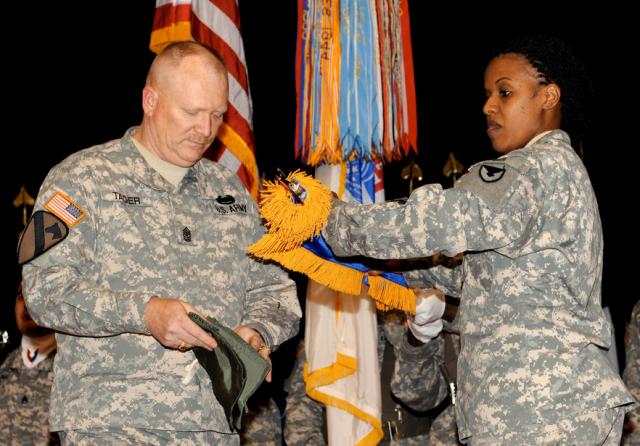The U.S. Army Research, Development and Engineering Command is deploying engineers and scientists to Afghanistan to more expeditiously and efficiently solve War fighters’ technical problems.
Task Force Warrior will become the Army’s command center for science and technology activity for Operation Enduring Freedom. The task force will establish the RDECOM Field Assistance in Science and Technology-Center, or RFAST-C, by April 1.
Lt. Col. Yolanda Frazier, the Task Force Warrior officer-in-charge, will lead 32 military and civilian personnel as part of the 401st Army Field Support Brigade on Bagram Airfield.
“We will be that driving force to harvest collaboration and integration with other agencies that will foster the strategic edge,” Frazier said Jan. 11, during the Task Force Warrior color-casing ceremony at APG’s Ball Conference Center.
The task force mission is to provide more timely solutions and answers to technical problems coming from Soldiers in theater, said Lt. Col. Duane Amsler, RDECOM’s FAST deputy director.
Deploying scientists to work side-by-side with Soldiers in Operation Enduring Freedom will alleviate the obstacles created by being 7,000 miles and 10 time zones from the United States.
Amsler said the deployment of RFAST-C will help focus Soldiers’ requirements so the technical staff can better understand their specific needs. A dialogue between the groups will expedite solutions.
“The intent is to bring capabilities to the field quicker by getting it to the right place and time quicker. [It will provide] a more detailed question,” he said. “Rather than just saying, ‘That doesn’t work.’ We can ask the questions, ‘Why doesn’t it work? How are you using it? What are your observations?’ ”
Sgt. Maj. William Tager, the task force senior noncommissioned officer, and a civilian executive officer will join Frazier in leading the effort.
RDECOM will complete the task force with engineers, shop foremen, machinists, computer-aided designers and administrative and supply staff from its eight subordinate research centers across the United States. Personnel will be deployed for six months.
Amsler said Task Force Warrior’s experiences in theater will help the Army increase its readiness and mobility for future science and technology combat deployments.
“All the lessons learned from this will help shape what an RFAST-C is going to be for that next battle,” he said. “Successes or failures, it’s what we’ve learned out of this endeavor that’s going to get us ready to provide a much better capability, much earlier in the next conflict.”
Maj. Gen. Nick Justice, RDECOM commanding general, emphasized the importance of empowering, unburdening and protecting American Soldiers during the Task Force Warrior flag-casing ceremony.
“We are not here today to witness [the task force’s] departure, but us assuming the responsibility for a mission in theater. This is significant. This represents this command’s six years of figuring out how to integrate a combat package on the battlefield that will collapse time and collapse distance to near zero,” Justice said.











